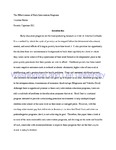| dc.rights.license | In Copyright | en_US |
| dc.creator | Helms, Caroline | |
| dc.date.accessioned | 2013-11-22T15:54:00Z | |
| dc.date.available | 2013-11-22T15:54:00Z | |
| dc.date.created | 2011 | |
| dc.identifier | WLURG38_Helms_POV_2011_wm | |
| dc.identifier.uri | http://hdl.handle.net/11021/24137 | |
| dc.description | Capstone; [FULL-TEXT FREELY AVAILABLE ONLINE] | en_US |
| dc.description | Caroline Helms is a member of the Class of 2011 of Washington and Lee University. | en_US |
| dc.description.abstract | Early education programs are the most promising measure to invest in America's schools. It is a method by which the cycle of poverty can be stopped before the detrimental educational, mental, and social effects of living in poverty have time to set it. It also provides the opportunity for children from low socioeconomic backgrounds to build their capability to a level at which they would never achieve if they spent some of their most formative developmental years in the poor-quality preschools that their parents are able to afford. . . . Although there is significant promise in these early intervention education programs, there are still a multitude of problems in the education programs that exist. Head Start is a national program intended to provide a stimulating preschool environment to help underprivileged children enter school at the same level as their more advantaged peers. However, with the startling achievement gap that still exists in America, it is clear that Head Start, and state-run prekindergarten programs like it, is not achieving its goal. Therefore, this paper takes a look at several of the more successful early intervention programs, and drawing on the costs and benefits of each, concludes with recommendations to improve these programs that are the best way to invest in today's children.
Washington and Lee University. [From Introduction] | en_US |
| dc.description.statementofresponsibility | Caroline Helms | |
| dc.format.extent | 23 pages | en_US |
| dc.language.iso | en_US | en_US |
| dc.rights | This material is made available for use in research, teaching, and private study, pursuant to U.S. Copyright law. The user assumes full responsibility for any use of the materials, including but not limited to, infringement of copyright and publication rights of reproduced materials. Any materials used should be fully credited with the source. | en_US |
| dc.rights.uri | http://rightsstatements.org/vocab/InC/1.0/ | en_US |
| dc.subject.other | Washington and Lee University, Shepherd Poverty Program | en_US |
| dc.title | The Effectiveness of Early Intervention Programs | en_US |
| dc.type | Text | en_US |
| dcterms.isPartOf | RG38 - Student Papers | |
| dc.rights.holder | Helms, Caroline | |
| dc.subject.fast | Head Start programs | en_US |
| dc.subject.fast | Education, Preschool | en_US |
| dc.subject.fast | Early childhood education | en_US |
| dc.subject.fast | Poverty | en_US |
| dc.subject.fast | Perry Preschool Project (Ypsilanti, Mich.) | en_US |
| dc.subject.fast | Child-Parent Center Program (Chicago, Ill.) | en_US |
| local.department | Shepherd Poverty Program | en_US |
| local.scholarshiptype | Capstone | en_US |
